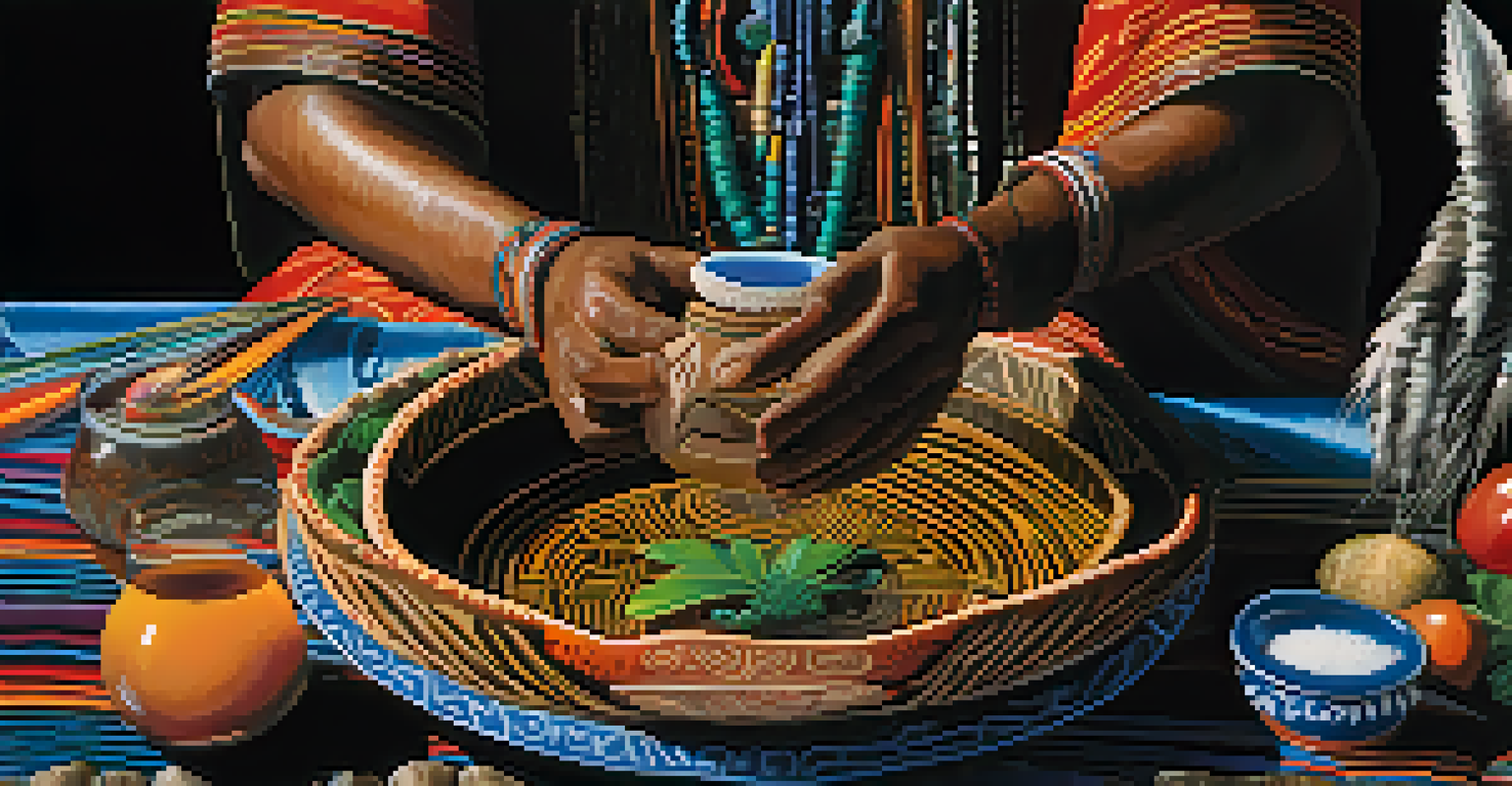Exploring the Role of Setting in Ayahuasca Ceremonies

Understanding Ayahuasca and Its Ceremonial Context
Ayahuasca is a powerful psychedelic brew traditionally used in Amazonian shamanic practices. It combines the Banisteriopsis caapi vine and the leaves of the Psychotria viridis plant, creating a profound experience for those who partake in it. The ceremonies often include a shaman or facilitator who guides participants through their journey, emphasizing the importance of a supportive environment.
The setting in which we experience Ayahuasca is as important as the medicine itself.
The ceremonial context of Ayahuasca is rich with cultural significance, often integrating music, chanting, and rituals that have been passed down through generations. These elements contribute to the overall atmosphere and can significantly shape an individual's experience. Understanding this context is crucial for anyone considering participating in an Ayahuasca ceremony.
Setting plays a pivotal role in these ceremonies, influencing not just the physical space but also the emotional and psychological environment. A well-prepared setting can enhance feelings of safety and openness, allowing participants to dive deeper into their inner experiences.
The Physical Environment: Space and Comfort
The physical environment of an Ayahuasca ceremony can greatly impact participants' comfort and receptivity. A clean, inviting space with soft lighting and comfortable seating can create a sense of tranquility, essential for introspective work. In contrast, a chaotic or cluttered environment may distract and detract from the experience.

Many ceremonies take place in natural settings, surrounded by the lush greenery of the Amazon rainforest. This natural backdrop not only enhances the aesthetic appeal but also connects participants to the earth, fostering a sense of unity with nature. Such settings can evoke feelings of awe and wonder, which may amplify the psychedelic experience.
Setting Shapes Ayahuasca Experience
The physical and emotional setting plays a crucial role in influencing participants' comfort and depth of their journeys.
Additionally, the arrangement of the space is important. Participants often sit or lie in circles, facilitating a sense of community and shared experience. This layout helps to establish a supportive atmosphere, encouraging individuals to feel safe and connected during their journey.
The Role of the Facilitator in Shaping the Experience
The facilitator, often a shaman or experienced guide, plays a crucial role in the Ayahuasca ceremony. Their presence and actions can significantly influence the participants' emotional and psychological journey. A skilled facilitator creates a safe space, offering guidance and support as individuals navigate their experiences.
In the depths of the journey, it is the community and the facilitator that hold the space for transformation.
Facilitators often use music, songs, or icaros—traditional healing chants—to create an emotional landscape that resonates with participants. This soundscape can enhance the journey, helping to soothe fears or amplify insights. The right facilitator can transform a challenging experience into one of profound healing and understanding.
Moreover, the facilitator's energy and demeanor can set the tone for the entire ceremony. A calm, confident presence can instill trust in participants, allowing them to surrender to the experience fully. This trust is vital for individuals to explore the depths of their consciousness without fear.
Community and Collective Energy in Ceremonies
The community aspect of Ayahuasca ceremonies is another critical element of the setting. Sharing the experience with others can create a sense of belonging and support, helping individuals feel less isolated in their journeys. This shared energy can amplify insights and emotional healing.
Participants often report feeling a profound connection to one another during the ceremony, fostering empathy and understanding. This collective energy can facilitate a deeper exploration of personal issues, as individuals learn from each other's experiences. It's as if the group's combined energy creates a unique container for transformation.
Facilitators Guide the Journey
Experienced facilitators create a safe and supportive atmosphere, using techniques like music and guidance to enhance participants’ experiences.
This sense of community doesn't just end with the ceremony; it can extend into post-ceremony integration. Participants often share their experiences, providing an additional layer of support and understanding as they process their journeys. This ongoing connection can be vital for long-term healing.
Intentions and Their Impact on the Journey
Setting intentions is a common practice before participating in an Ayahuasca ceremony. These intentions guide participants, helping them focus their thoughts and energies during their journey. A clear intention can serve as a compass, directing the experience toward healing or insight.
In a supportive setting, participants are encouraged to articulate their intentions, often in a group setting or through personal reflection. This process not only clarifies their goals but also fosters accountability. When individuals commit to their intentions, they are more likely to engage deeply with the experience.
Moreover, the energy of the group intentions can create a powerful collective focus. When everyone shares their intentions, it can amplify the overall experience, fostering a sense of unity and purpose within the community. This interconnectedness can enhance the individual journeys, providing a richer and more meaningful experience.
Post-Ceremony Integration: The Importance of Setting
Post-ceremony integration is a crucial phase that often involves reflecting on the insights gained during the Ayahuasca experience. The setting during this time can significantly influence how individuals process their journeys. A nurturing, supportive environment allows for open dialogue and sharing, which is essential for understanding and growth.
Many participants find that discussing their experiences with fellow participants or facilitators enhances their integration process. This communal setting fosters trust and openness, enabling deeper exploration of emotions and insights. It can also help individuals feel less alone as they navigate the complexities of their experiences.
Community Enhances Healing
The collective energy of participants fosters a sense of belonging and amplifies emotional healing during Ayahuasca ceremonies.
Creating a safe and reflective environment post-ceremony encourages participants to engage with their insights actively. Whether through journaling, art, or conversation, the right setting can facilitate healing and transformation, allowing the lessons learned during the ceremony to take root in everyday life.
Conclusion: The Lasting Impact of the Setting
In conclusion, the setting of an Ayahuasca ceremony is not merely a backdrop; it is a fundamental component that shapes the entire experience. From the physical environment to the community dynamics, each element contributes to how individuals engage with their journeys. A thoughtfully created setting can enhance safety, trust, and openness, allowing for deeper exploration.
As more people seek out Ayahuasca experiences, understanding the importance of setting becomes increasingly vital. Participants should prioritize finding spaces and facilitators that resonate with their needs and intentions. This awareness can lead to more profound and transformative experiences.

Ultimately, the right setting can facilitate healing and growth, helping individuals integrate their experiences into their lives. As we continue to explore the depths of consciousness through these ceremonies, let us remember the profound impact that setting has on our journeys.